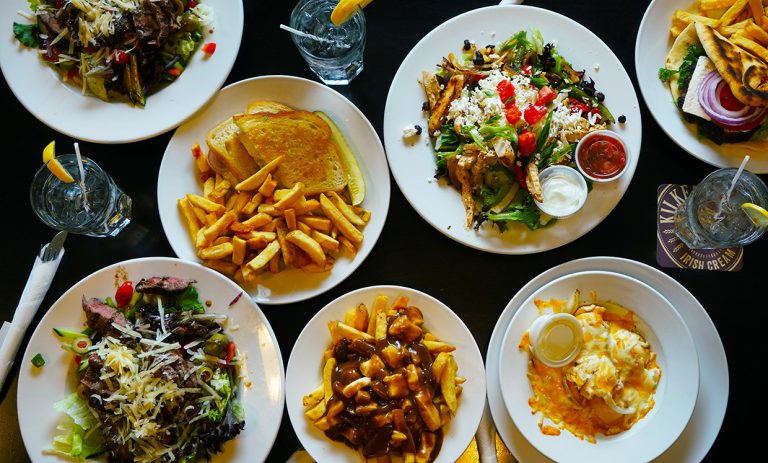10 Must-Try Korean Dishes

Food is a very important aspect of Korean culture. It’s always enjoyed in a group setting and almost always ‘family style’ – everyone helping themselves to the various dishes on the table. Korea may be one of the few places where double dipping is allowed, even encouraged. Friends and co-workers meet over meals and business deals are usually sealed at the dinner table. Your first thought of Korean cuisine is most likely Korean barbeque, but it’s not the only type of cuisine on the menu in the country. Having called Korea home for 2 years, I explored the culinary scene to my stomach’s content. Below is a list of 10 must-try Korean dishes when traveling through the country! Even if you can’t make the flight over, most of these dishes can be found in your city’s Koreatown as well.
Table of Contents
Bibimbap

For the uninitiated to Korean cuisine, bibimbap is a great place to start on your culinary adventure. It’s essentially a big bowl of rice with various vegetables arranged on top, in an Instagram-worthy way, and can include the addition of meat (bulgogi) and/or a sunny-side up egg. A sauce prepared with gochujang (chili pepper paste), vinegar, and sesame oil is added to the dish to give it a little kick. The Korean word ‘bibimbap’ translates to ‘mixed rice’ and that’s exactly how you eat it. Take your spoon and mix everything up, making sure to blend the ingredients well. My favourite style of bibimbap is ‘dolsot bibimbap’ or stone-pot bibimbap. The dish comes out in a hot stone bowl, further cooking the ingredients and making the rice at the bottom nice and crispy.
Pajeon

Korea’s version of a pancake, pajeon is typically made with green onions embedded in a thick pancake-like batter. There are various versions of this dish with a variety of ingredients but my favourite is haemul pajeon, a seafood version which usually includes squid, shrimp, oysters and clams. A dipping sauce containing a mixture of soy sauce, vinegar, sugar, onion, chili peppers and sesame seeds also accompanies the dish. Pajeon is best enjoyed with a bowl of dongdongju, a type of milky looking rice-wine alcohol similar in style to makgeolli, and is the go-to food choice for Koreans on a rainy day.
Kimchi Jjigae

Kimchi is a staple in every Korean household and restaurant and is consumed by Koreans on a daily basis. It’s eaten on its own and used in a variety of dishes, including kimchi jjigae. It’s a basic soup that’s made by first frying up old kimchi in a pot with a little bit of sesame seed oil. Water and additional gojujang (red pepper paste) is added and brought to a boil. Green onions and thin enoki mushrooms are then added at the end. It’s common to add a can of tuna to the soup to give it more substance and it’s always consumed with a small bowl of rice. Kimchi jjigae was the very first dish I ever learned to cook in Korea and I still make it to this day.
Soondubu Jjigae
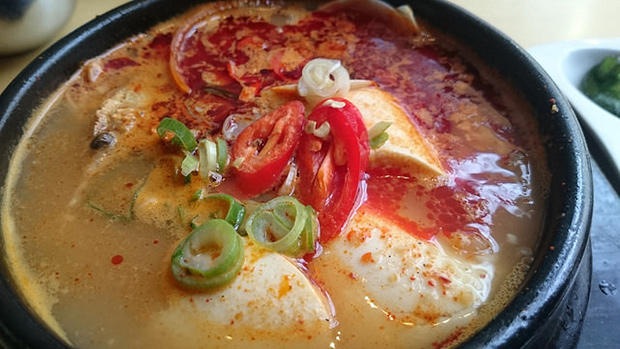
Soondubu jjigae, or tofu stew, is similar to kimchi jjigae but with the addition of seafood (usually shrimp and muscles) and a hearty supply of soft tofu. A raw egg is served alongside the dish. When the bowl of soondubu jjigae arrives at your table still boiling away, you crack the raw egg into the stew allowing the piping hot broth to cook it. Soondubu jjigae is also accompanied by a bowl of rice and makes for a great breakfast.
Gamjatang
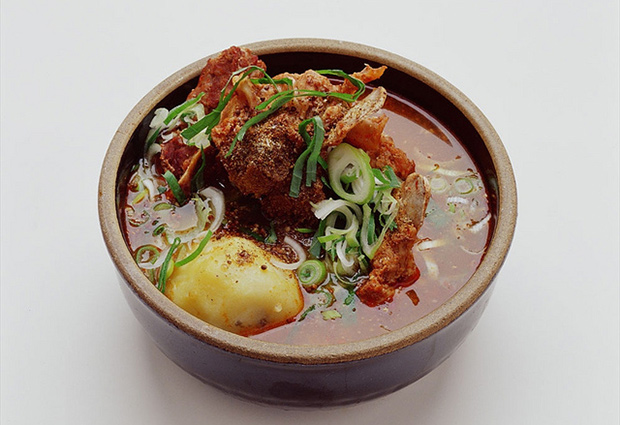
Pork spine may not be a common choice in western cooking but Koreans have used this to create one hell of a recipe! Gamjatang, or Pork Bone Soup (also called Potato Stew), is a spicy stew loaded with pieces of pork spine, potatoes, and vegetables. When cooked right, this stew is exactly what the doctor ordered on a cold winter day. The broth is rich and spicy and the meat from the bones are juicy and tender. A bowl of rice always accompanies gamjatang, to help reduce the spiciness of the dish.
Naengmyeon

Naengmyeon is a cold noodle dish consisting of buckwheat noodles, sliced pickled diakon radish, sliced cucumbers and pears, half a hard-boiled egg, sitting in a broth made from mushrooms, kelp, and dried anchovies mixed with vinegar, sugar, and salt. The tangy flavour of the broth is complimented by a mustard paste that is added to the dish to your liking (it’s spicy, so add a little at a time). There are two main varieties of naengmyeon; mul naengmyeon and bibim naengmyeon. Mul naengmyeon takes the original recipe and adds more broth and ice cubes to the dish while bibim naengmyeon replaces the broth with a spicy sauce. Naengmyeon is usually enjoyed in the warm summer months.
Budae Jjigae

Budae Jjigae has an interesting story for how it became a part of Korean cuisine. Back in the early 50s when the fighting between North and South Korea subsided, food was hard to come by. In desperation, Koreans would frequent the American Army bases collecting any of the unused or discarded cans of Spam and hot dogs. They then boiled them up with whatever other edible ingredients they could get (usually red peppers and kimchi) and made a stew out of it. Today it’s usually referred to as ‘army stew’ or even ‘garbage stew’ but don’t let the names throw off your appetite. Budae jjigae is now made with a variety of ingredients but usually includes tofu, vegetables, instant noodles, and yes, Spam and hot dogs. While budae jjigae may taste great going down, it’s not the most pleasant experience coming out… Plan accordingly.
Samgyetang
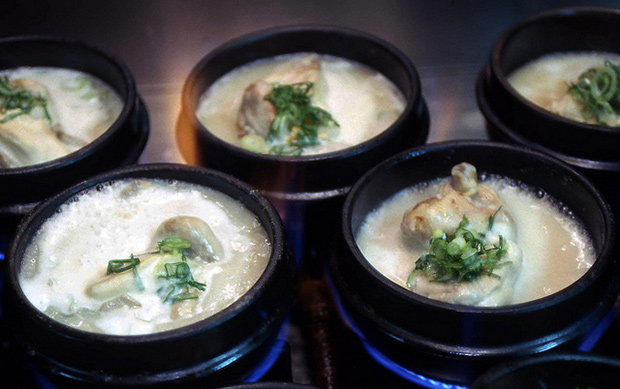
A lot of Korean cuisine is consumed for medicinal purposes; there’s a particular soup that only pregnant women will eat, some ingredients and dishes promise enhanced ‘man-strength’, and when the weather is getting too hot there’s soup for that too. Samgyetang, or ginseng chicken soup, is the dish to eat when the weather is hot and you need to maintain your energy levels. In fact, samgyetang is mainly consumed during the hottest days of the year (I also enjoyed making it during the winter months). To make it, a whole chicken is stuffed with rice, green onions, garlic, jujube, and ginseng. It’s then placed into a pot, covered with water, and cooked for about an hour and a half. The grocery stores in Korea made making samgyetang easy since they sold these ‘kits’ with all the ingredients I needed in one package.
Doshirak
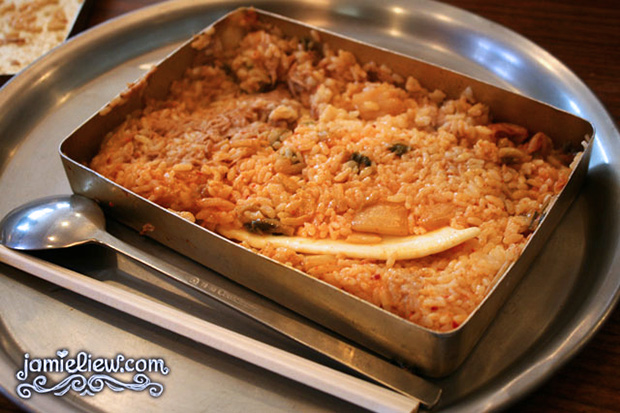
A simple yet delicious dish, doshirak was once considered ‘poor-people food’ but has been gaining popularity over the years. It’s comprised of rice, kimchi, dried seaweed, egg and gochujang. When you order it, it arrives at your table in a rectangular metal box with all the ingredients nicely arranged inside. With the box closed, you then vigorously shake it so the contents mix together, resulting in a gobbledy-goop mixture of flavours. Doshirak’s were Korea’s version of the lunch box. Before schools started serving lunches, children were sent to school with doshiraks, placing them on heaters to keep warm until lunch time.
Patbingsu
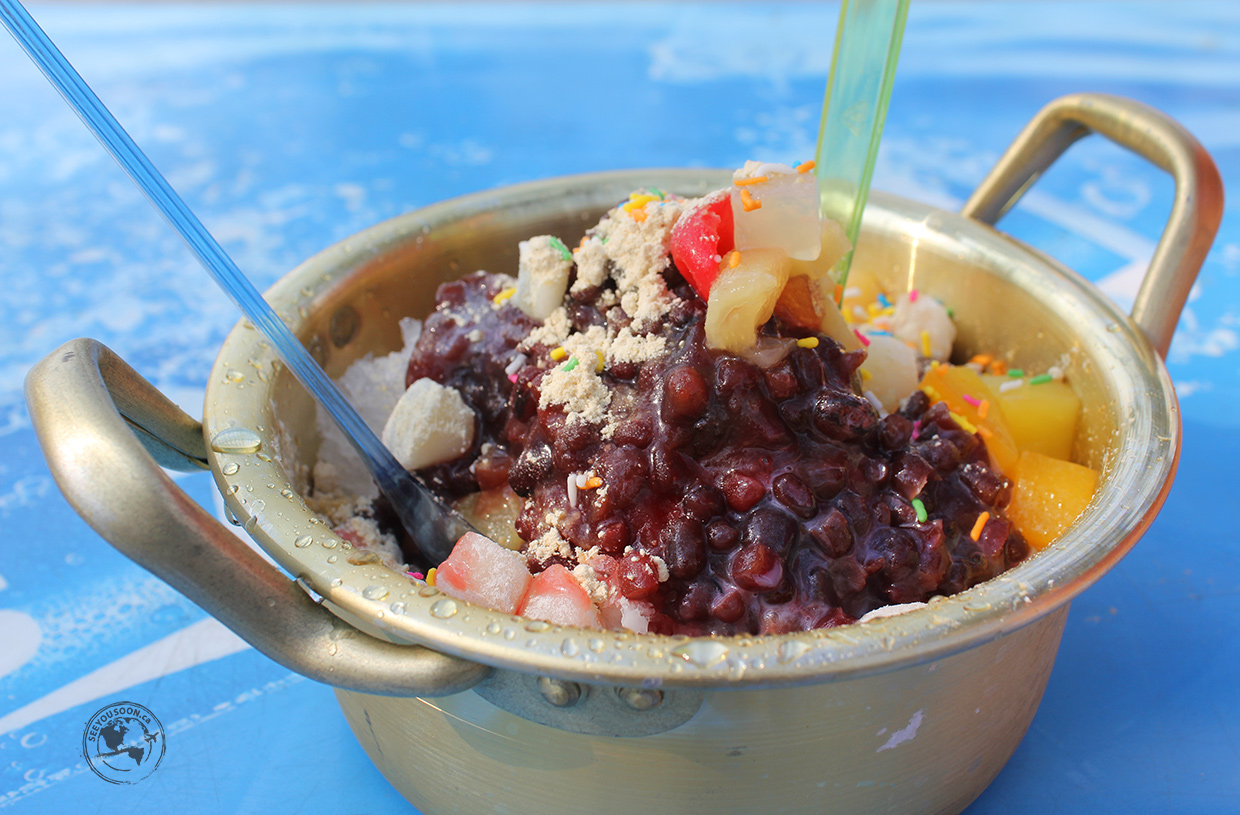
Desserts aren’t South Korea’s specialty but when the weather warms up Koreans love to dig into patbingsu, a shaved ice dish commonly found in parts of Asia and Southeast Asia. Patbingsu is made by layering the bottom of a dish with shaved ice and topped with red beans, condensed milk and pieces of jellied fruit. The popularity of patbingsu has increased over the years and many places offer very elaborate options that also include mini marshmallows, ice cream, fruit, and various syrups.
Bonus: Sannakji
Are you an adventurous eater? And by adventurous, I mean are you the type of person that eats foods most people would cringe at? Then you can’t leave Korea without eating sannakji – live octopus. Sannakji is essentially small octopuses that are cut into pieces immediately before being served at your table. It’s so fresh that the pieces are still wiggling away on your plate! To eat it, you have to dip the pieces into a spicy sauce so the suction cups on the arms close and don’t latch onto the inside of your mouth. There’s definitely some risk involved in eating this dish!
Do you have a favourite Korean dish or feel that I missed one that people must try? Leave them in the comments below!
